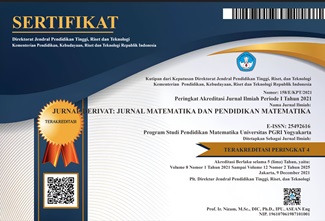Commognitive Kesalahan Mahasiswa Melalui Aktivitas Diskusi dalam Menyelesaikan Soal Cerita
DOI:
https://doi.org/10.31316/jderivat.v10i3.5061Abstract
Describing students’ cognitive errors in solving binomial problems using calculations and minitab. This type of research uses descriptive qualitative with the research subjects, which were 17 Mathematics Education Class 2020A students at one of the Private Universities (PTS) in Lumajang Regency. The results obtained are the ability of students with research instruments in the form of math ability test sheets, group assignment sheets, recording tools. The results of cognitive errors obtained from the high category in the form of word usage errors such as incomplete in writing known. Narrative errors such as not writing concepts in calculations. Visual mediator errors caused by low understanding of binomial concepts. Next, the errors made by the medium and low categories are the same. The errors are in the form of word usage errors such as errors in translating language in story problems and incomplete in writing known. Narrative errors such as not writing the concept of binomial in the calculation. Routine errors such as errors in calculations caused by incorrect previous steps and not writing conclusions.
Keywords: Comognitive Error; Discussion Activity; Story Problem; Binomial
References
Acharya, B. R. (2017). Factors Affecting Difficulties in Learning Mathematics by Mathematics Learners. International Journal of Elementary Education, 6(2), Article 2. https://doi.org/10.11648/j.ijeedu.20170602.11
Agustin, D. R., Murniasih, T. R., & Fayeldi, T. (2023). Bagaimana Bentuk Kesalahan Siswa dalam Menyelesaikan Soal Cerita Berdasarkan Prosedur Newman? Jurnal Edumath, 9(1), 1–10. https://doi.org/10.52657/je.v9i1.1935
Agustin, D. R., & Permadi, H. (2020). Pembelajaran Daring Berbantuan Minitab dalam Menyelesaikan Kasus Multikolinearitas Ditinjau dari Komunikasi Matematis Tulis Siswa. Seminar Nasional Matematika dan Pembelajarannya, 350–361. http://matematika.fmipa.um.ac.id/seminar/2020/
Anggraini, C., Ritonga, D. H., Kristina, R., Syam, M., & Kustiawan, W. (2022). Komunikasi Interpersonal. Jurnal Multi Disiplin Dehasen (MUDE), 1(3), 337–342. https://jurnal.unived.ac.id/index.php/mude/article/view/2611/2124
Halim, D., Nurhidayati, S., Zayyadi, M., Lanya, H., & Hasanah, S. I. (2020). Commognitive analysis of the solving problem of logarithm on mathematics prospective teachers. Journal of Physics: Conference Series, 1663(1), 012002. https://doi.org/10.1088/1742-6596/1663/1/012002
Lutviana, E., Nusantara, T., & Sudirman. (2022). Commognitive Students’ During Discussion in Solving Skewness and Kurtosis Problem. Jurnal Pendidikan Sains, 9(1), 10–22. http://journal.um.ac.id/index.php/jps/article/view/15080/6704
Mandasari, R., Chandra, T. D., & Dwiyana. (2018). Kemampuan Komunikasi Matematis Tulis Siswa SMP dalam Menyelesaikan Masalah. Jurnal Pendidikan: Teori, Penelitian, dan Pengembangan, 3(7), 838–850.
Masrukan, Susilo, B. E., & Pertiwi, A. D. (2015). Analysis of Mathematical Communication Ability through 4K Model based on 7th Grades’ Personality Types. International Journal of Education and Research, 3(7), 343–352. www.ijern.com
Moleong, L. J. (2011). Metodologi Penelitian Kualitatif. PT. Remaja Rosdakarya.
Nugroho, W. (2021). Pendekatan Problem Based Learning Model Diskusi Kelompok Berbantuan Video YouTube untuk Meningkatkan Aktivitas dan Hasil Belajar Statistika. Jurnal Pendidikan Matematika, 4, 211–226. https://doi.org/10.21043/jmtk.v4i2.12259
Parotua, A. J., & Junaedi, I. (2019). The ability of mathematical creative thinking viewed from student learning interest of class VIII in learning CPS contextual approach. 8(1).
Qudsi, R., Sthephani, A., & Safitri, D. (2019). Leadership Training untuk Mengasah Kemampuan Intrapersonal dan Interpersonal dalam Berorganisasi. Community Education Engagement Journal, 1(1), 52–57. https://doi.org/10.25299/ceej.v1i1.3672
Sfard, A. (2012). Introduction: Developing mathematical discourse—Some insights from communicational research. International Journal of Educational Research, 51–52, 1–9. https://doi.org/10.1016/j.ijer.2011.12.013
Sinaga, M. I., Sinaga, B., & Napitupulu, E. (2021). Analysis of Students’ Mathematical Communication Ability in the Application of Vygotsky’s Theory at High School Level. Budapest International Research and Critics in Linguistics and Education (BirLE) Journal, 4(1), 132–144. https://doi.org/10.33258/birle.v4i1.1567
Siregar, N. (2022). Kemampuan Pemecahan Masalah Matematis Mahasiswa PGMI Pada Materi Volume Bangun Ruang: PGMI Students’ Mathematical Problem Solving Ability in Constructing Volume Material. Jurnal Derivat: Jurnal Matematika Dan Pendidikan Matematika, 9(2), Article 2. https://doi.org/10.31316/jderivat.v9i2.2711
Supardi, L., Lanya, H., Hasanah, S. I., & Hidayati, S. N. (2021). Commognitive Analysis Of Students’ Errors In Solving High Order Thinking Skills Problems. Turkish Journal of Computer and Mathematics Education (TURCOMAT), 12(6), 950–961. https://doi.org/10.17762/turcomat.v12i6.2373
Suyitno, A., & Suyitno, H. (2015). Learning Therapy for Students in Mathematics Communication Correctly Based-on Application of Newman Procedure (A Case of Indonesian Student). International Journal of Education and Research, 3(1), 529–538. www.ijern.com
White, A. L. (2018). Australian Mathematics Literacy Perspectives: Assessment. Southeast Asian Mathematics Education Journal, 8(1), 69–82. https://doi.org/10.46517/seamej.v8i1.65
Zayyadi, Moh., Lutfiyah, & Pratiwi, E. (2023). Analisis Commognitive Siswa dalam Menyelesaikan Soal Non Rutin. Jurnal Axioma: Jurnal Matematika dan Pembelajaran, 8(1), 22–36. https://doi.org/10.56013/axi.v8i1.1990
Downloads
Published
Issue
Section
Citation Check
License
Copyright (c) 2023 Devi Rahayu Agustin

This work is licensed under a Creative Commons Attribution-ShareAlike 4.0 International License.
Authors who publish with this journal agree to the following terms:
-
Authors retain copyright and grant the journal right of first publication with the work simultaneously licensed under a Creative Commons Attribution-ShareAlike 4.0 International License that allows others to share the work with an acknowledgment of the work's authorship and initial publication in this journal.
- Authors are able to enter into separate, additional contractual arrangements for the non-exclusive distribution of the journal's published version of the work (e.g., post it to an institutional repository or publish it in a book), with an acknowledgment of its initial publication in this journal.
- Authors are permitted and encouraged to post their work online (e.g., in institutional repositories or on their website) prior to and during the submission process, as it can lead to productive exchanges, as well as earlier and greater citation of published work (See The Effect of Open Access).







